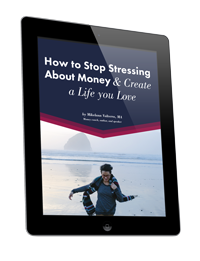You know my motto: Earn more and spend wisely! So this post is about that second part- because it doesn’t matter if you earn more- if you blow it all at Target. Well, thanks to the hot new field of “neuroeconomics”, I’ve learned another bit of shopping advice.
Recently, I wrote in a post about going to Home Depot and what happens when you buy something big and then follow it up by buying a lot of small things. Those small things really start to feel free, in comparison.
I mentioned that I have this habit where I always tell myself I can throw anything in my cart, but it doesn’t mean I’ll buy it.
Now I’m thinking I should rethink that habit, due to what neuro-economists call “the endowment effect.” Brian Knutson, an associate professor of psychology and neuroscience at Stanford, has written about this. Basically, he says that you should avoid hanging on to items you’re thinking of buying in a store. When you carry them around with you, they start to feel like yours. Then you experience pain when you think about getting rid of them. In essence, you will feel like you are “losing” these objects if you don’t buy them, because you’ve become attached to them. They’ve done interesting studies to support this, all of which point to the same thing: when you have an object in your possession, it feels like “yours”, and you start to value it more then you should. It’s not really conscious.
If I hit Bed, Bath and Beyond and pick up the bamboo cutlery organizer which is right at the entrance to the store, and then proceed to carry it around with me for twenty minutes while I look at other things, well,…. It gets harder to let go of. I’ve pictured it in my kitchen and held it for a while. The point is that it is more painful to put it back then we realize. If I had left it on its shelf and then gone back to check it out at the end, I would be less likely to buy it. But who wants to have to go all the way back to the front of the store? (Stores know this, of course. They steer you around more purposefully then we know.)
When my son was younger, he was into “Rescue Heroes”. (They are basically action figures for younger kids.) We went to Toys R Us one day to spend a gift certificate and his allowance. While there were many things he wanted, the Rescue Hero’s display was the first thing he saw. So he picked up Billy Blazes and carted him around the store while we were looking. Well, surprise- even though he found a Lego set that he had talked about for a LOT longer, he simply couldn’t give up Billy Blazes. It was too painful to part with him. The toy already felt like his.
I guess we’re not that different. So I think that I’ll stop carrying stuff around in my cart while I “debate” buying it. Because it does start to feel painful to part with my stuff…

That’s so true! That’s why I talk about the importance of shopping with a list and sticking to the list. If you walk into BB&B without a list — good luck! There are so many tempting things like new towels, candles, kitchen gadgets, and more, that will seem so practical and important at the time — but you don’t really NEED any of them.
With clothes shopping, which is more my area, it is even more important to know exactly what piece of clothing you’re looking for — also identify the colors and style you are looking for before you walk into the store. Otherwise you will end up with a closet full of clothes that don’t coordinate. And if you have a color card with you (yes, I sell them on my website!) it will REALLY help you choose the colors that make you look radiant. And you’ll save money — you will buy clothes that mix and match with the things you have at home.
Great article! Thank you!
Linda
Understanding this “endowment effect” can certainly help every shopper, no matter where we shop, and for every item we think we want to purchase. Now we have additional ammunition to use when entering enemy territory (i.e. BB&B, or big box stores, or cute little clothing boutiques)!
Strategies like this one not only help us to save the money we work hard to earn, but also keep our homes from filling up with stuff we don’t really need or want. Seeing something “cute” in a store does not necessarily mean we want it, will use it, or need it. It’s good to acknowledge that something we see is beautiful, clever, useful, or even necessary, but it does not mean we have to take it home with us. Now you have given us another strategy to employ to keep money in our purses and our homes from filling up with “stuff.”
Thanks for making this information available to your readers!